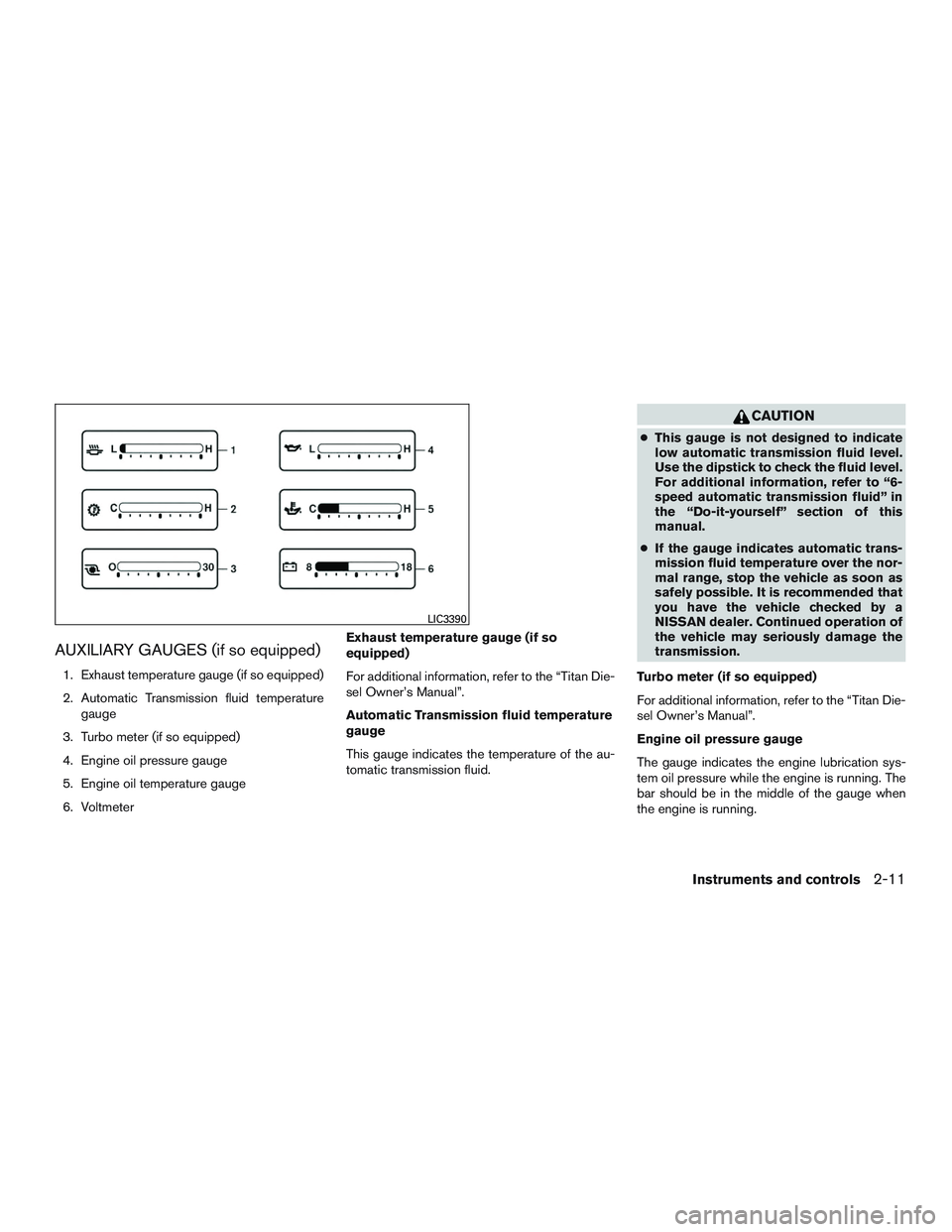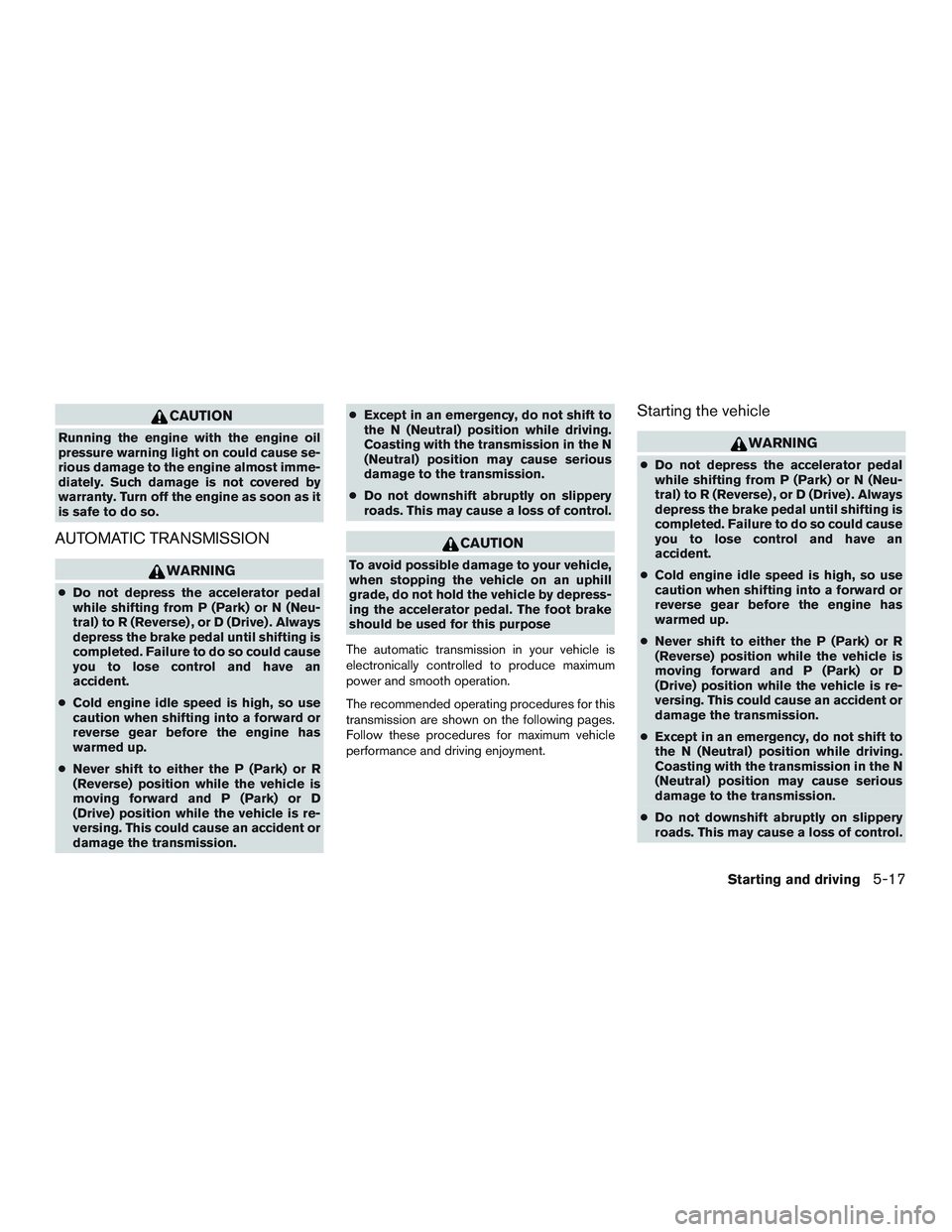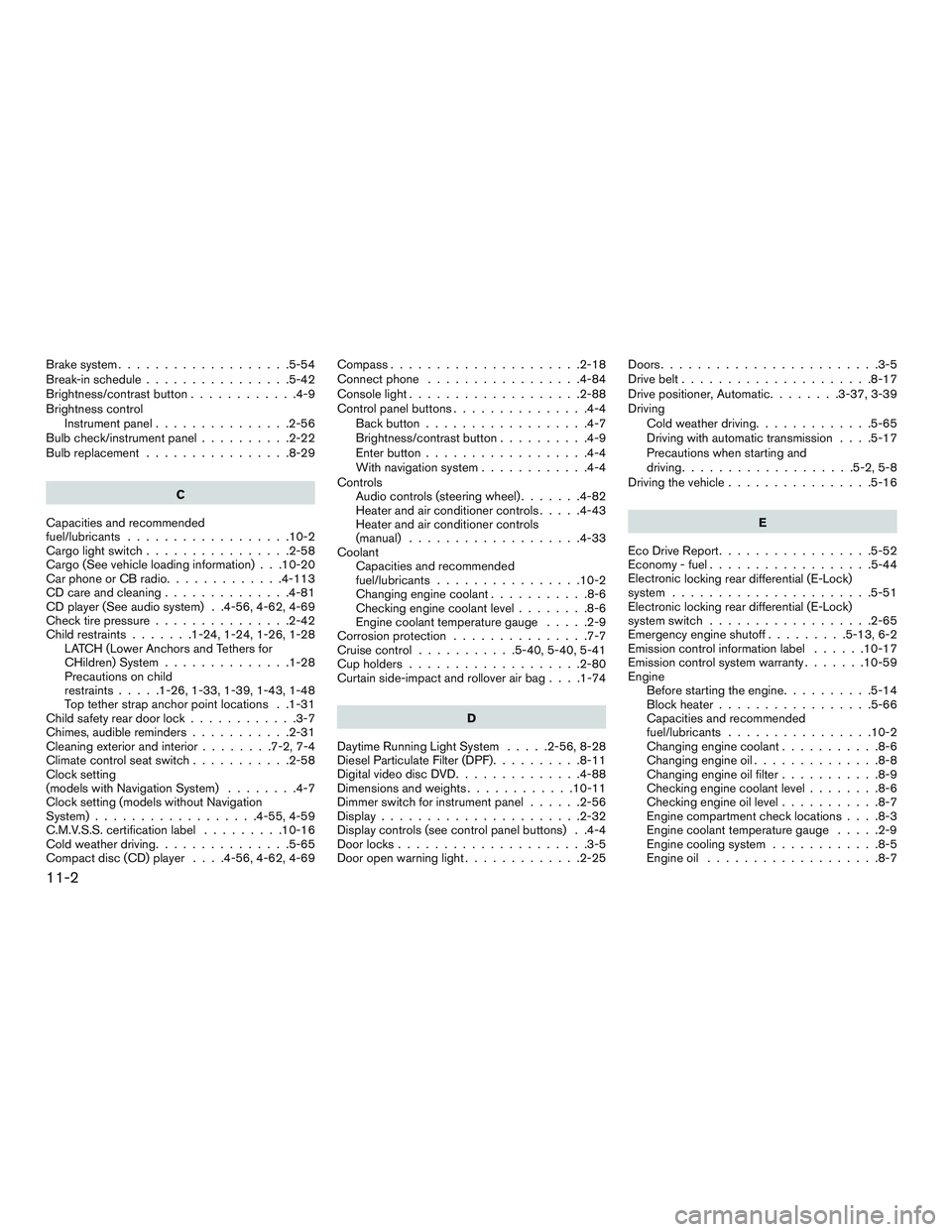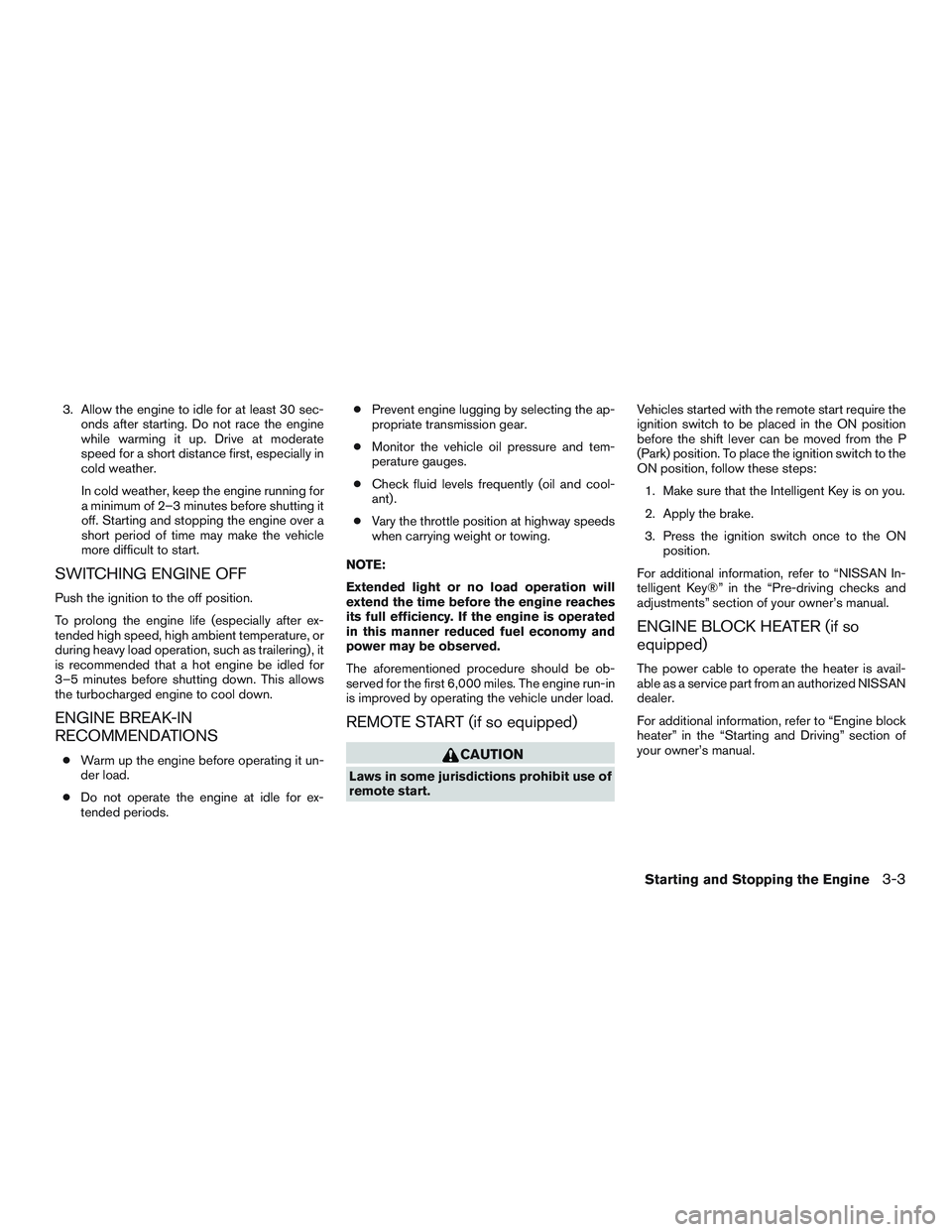2017 NISSAN TITAN XD oil pressure
[x] Cancel search: oil pressurePage 114 of 671

AUXILIARY GAUGES (if so equipped)
1. Exhaust temperature gauge (if so equipped)
2. Automatic Transmission fluid temperaturegauge
3. Turbo meter (if so equipped)
4. Engine oil pressure gauge
5. Engine oil temperature gauge
6. Voltmeter Exhaust temperature gauge (if so
equipped)
For additional information, refer to the “Titan Die-
sel Owner’s Manual”.
Automatic Transmission fluid temperature
gauge
This gauge indicates the temperature of the au-
tomatic transmission fluid.
Page 394 of 671

CAUTION
Running the engine with the engine oil
pressure warning light on could cause se-
rious damage to the engine almost imme-
diately. Such damage is not covered by
warranty. Turn off the engine as soon as it
is safe to do so.
AUTOMATIC TRANSMISSION
Page 599 of 671

Brake system...................5-54
Break-in schedule ................5-42
Brightness/contrastbutton............4-9
Brightness control Instrument panel ...............2-56
Bulb check/instrument panel ..........2-22
Bulb replacement ................8-29
C
Capacities and recommended
fuel/lubricants ..................10-2
Cargolightswitch................2-58
Cargo (See vehicle loading information) . . .10-20
Car phone or CB radio .............4-113
CD care and cleaning ..............4-81
CD player (See audio system) . .4-56, 4-62, 4-69
Check tire pressure ...............2-42
Child restraints .......1-24,1-24,1-26,1-28
LATCH (Lower Anchors and Tethers for
CHildren) System ..............1-28
Precautions on child
restraints.....1-26,1-33,1-39,1-43,1-48
Top tether strap anchor point locations . .1-31
Child safety rear door lock ............3-7
Chimes, audible reminders ...........2-31
Cleaningexteriorandinterior........7-2,7-4
Climatecontrolseatswitch...........2-58
Clock setting
(models with Navigation System) ........4-7
Clock setting (models without Navigation
System) ..................4-55,4-59
C.M.V.S.S. certification label .........10-16
Cold weather driving ...............5-65
Compact disc (CD) player ....4-56,4-62,4-69Compass
.....................2-18
Connect phone .................4-84
Console light ...................2-88
Control panel buttons ...............4-4
Back button ..................4-7
Brightness/contrast button ..........4-9
Enterbutton..................4-4
With navigation system ............4-4
Controls Audio controls (steering wheel) .......4-82
Heater and air conditioner controls .....4-43
Heater and air conditioner controls
(manual) ...................4-33
Coolant Capacities and recommended
fuel/lubricants ................10-2
Changingenginecoolant...........8-6
Checking engine coolant level ........8-6
Engine coolant temperature gauge .....2-9
Corrosion protection ...............7-7
Cruisecontrol ...........5-40,5-40,5-41
Cupholders...................2-80
Curtainside-impactandrolloverairbag....1-74
D
Daytime Running Light System .....2-56,8-28
Diesel Particulate Filter (DPF) ..........8-11
Digital video disc DVD ..............4-88
Dimensionsandweights............10-11
Dimmer switch for instrument panel ......2-56
Display......................2-32
Display controls (see control panel buttons) . .4-4
Door locks .....................3-5
Door open warning light .............2-25 Doors
........................3-5
Drive belt .....................8-17
Drive positioner, Automatic ........3-37,3-39
Driving Cold weather driving .............5-65
Driving with automatic transmission ....5-17
Precautions when starting and
driving ...................5-2,5-8
Driving the vehicle ................5-16
E
Eco Drive Report .................5-52
Economy-fuel..................5-44
Electronic
locking rear differential (E-Lock)
system ......................5-51
Electronic locking rear differential (E-Lock)
system switch ..................2-65
Emergency engine shutoff .........5-13,6-2
Emission control information label ......10-17
Emission control system warranty .......10-59
Engine Before starting the engine ..........5-14
Blockheater.................5-66
Capacities and recommended
fuel/lubricants ................10-2
Changing engine coolant ...........8-6
Changingengineoil..............8-8
Changing engine oil filter ...........8-9
Checking engine coolant level ........8-6
Checking engine oil level ...........8-7
Engine compartment check locations ....8-3
Engine coolant temperature gauge .....2-9
Engine cooling system ............8-5
Engineoil ...................8-7
11-2
Page 600 of 671

Engine oil and oil filter recommendation . .10-7
Engine oil pressure gauge......2-11,2-12
Engine oil pressure warning light ......2-25
Engine oil viscosity ..............10-7
Engine serial number ............10-16
Engine specifications ............10-8
Engine coolant temperature gauge .......2-9
Engineoilpressuregauge........2-11,2-12
Enterbutton....................4-4
Event Data recorders .............10-61
Exhaust gas (Carbon monoxide) .........5-2
Explanation of maintenance items ........9-2
Explanation of scheduled maintenance items . .9-5
Extendedstorageswitch ............2-73
F
Flashers
(See hazard warning flasher switch) .......6-2
Flat tire .......................6-3
Floor mat positioning aid .............7-5
Fluid Brake fluid ..................8-13
Capacities and recommended
fuel/lubricants ................10-2
Engine coolant .................8-5
Engine oil ...................8-7
Power steering fluid .............8-12
Windshield-washerfluid...........8-13
F.M.V.S.S. certification label ..........10-16
Foglightswitch .................2-57
Four-Wheel Drive ................5-44
Front air bag system
(See supplemental restraint system) . .1-58, 1-72
Front and rear sonar system ..........5-60Front power seat adjustment
...........1-5
Frontseats.....................1-2
Fuel Capacities and recommended
fuel/lubricants ................10-2
Fuel economy ................5-44
Fuel gauge ..................2-10
Fuel octane rating ..............10-6
Fuel recommendation ............10-4
Loose fuel cap warning ...........2-45
Fuel Cell Vehicle (FCV) System Tirepressure.................8-32
Fuel efficient driving tips .............5-42
Fuel-filler door ..................3-23
Fuelgauge....................2-10
Fuses.......................8-21
Fusiblelinks ...................8-23
G
Garage door opener, HomeLink® Universal Trans-
ceiver .....2-89,2-90,2-91,2-92,2-92,2-93
Gauge Automatic transmission fluid temperature
gauge.....................2-11
Engine coolant temperature gauge .....2-9
Engine oil pressure gauge ......2-11,2-12
Fuel gauge ..................2-10
Odometer ...................2-8
Speedometer .................2-8
Tachometer ..................2-9
Trip computer ................2-13
Trip odometer .................2-8
Voltmeter...................2-12
General maintenance ...............9-2 Glovebox.....................2-77
Groceryhooks..................2-82
H
Hands-free phone system, Bluetooth® . . .4-114, 4-126
Hazard warning flasher switch ..........6-2
Headlightaimingcontrol ............2-55
Headlightandturnsignalswitch........2-53
Headlightcontrolswitch ............2-53
Headlights....................8-27
Headlights, aiming control ............2-55
Head restraints ..................1-10
Heated
rear seats ................2-61
Heated seats ...................2-60
Heated seat switches ..............4-85
Heated steering wheel switch .........2-62
Heater Heater and air conditioner (automatic)
(if so equipped) ...............4-42
Heater and air conditioner controls .....4-43
Heater operation ...........4-35,4-44
Heater and air conditioner (automatic) .....4-42
Hill descent control switch ...........2-64
Hill descent control system ...........5-59
Hill start assist system ..............5-60
HomeLink® Universal Transceiver . . .2-89, 2-90, 2-91, 2-92, 2-92, 2-93
Hood.......................3-22
Horn .......................2-58
11-3
Page 627 of 671

3. Allow the engine to idle for at least 30 sec-onds after starting. Do not race the engine
while warming it up. Drive at moderate
speed for a short distance first, especially in
cold weather.
In cold weather, keep the engine running for
a minimum of 2–3 minutes before shutting it
off. Starting and stopping the engine over a
short period of time may make the vehicle
more difficult to start.
SWITCHING ENGINE OFF
Push the ignition to the off position.
To prolong the engine life (especially after ex-
tended high speed, high ambient temperature, or
during heavy load operation, such as trailering) , it
is recommended that a hot engine be idled for
3–5 minutes before shutting down. This allows
the turbocharged engine to cool down.
ENGINE BREAK-IN
RECOMMENDATIONS
● Warm up the engine before operating it un-
der load.
● Do not operate the engine at idle for ex-
tended periods. ●
Prevent engine lugging by selecting the ap-
propriate transmission gear.
● Monitor the vehicle oil pressure and tem-
perature gauges.
● Check fluid levels frequently (oil and cool-
ant) .
● Vary the throttle position at highway speeds
when carrying weight or towing.
NOTE:
Extended light or no load operation will
extend the time before the engine reaches
its full efficiency. If the engine is operated
in this manner reduced fuel economy and
power may be observed.
The aforementioned procedure should be ob-
served for the first 6,000 miles. The engine run-in
is improved by operating the vehicle under load.
REMOTE START (if so equipped)